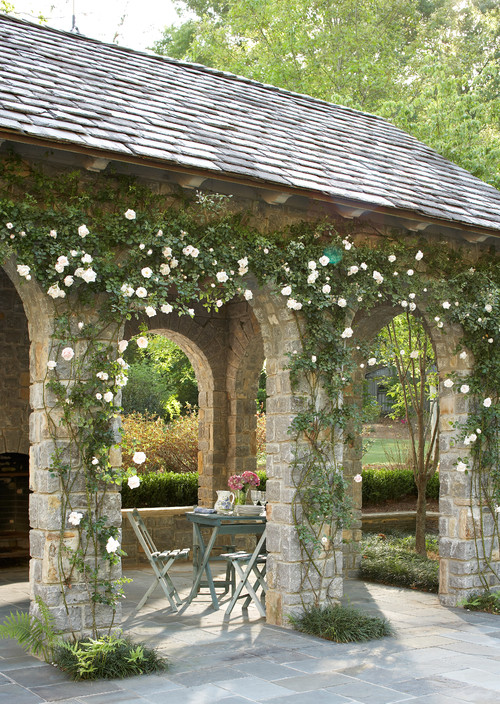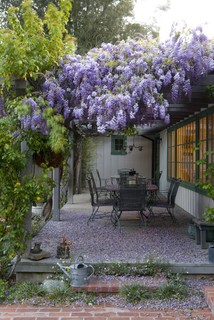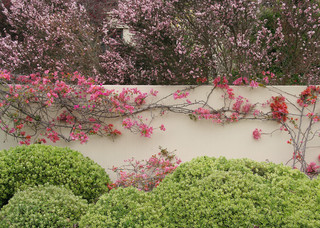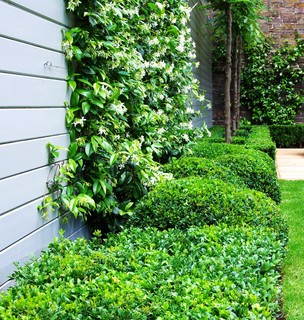Wonder Wall: The Climbing Plants That Can Improve Your Garden

Carol Bucknell 26 May 2017 Houzz New Zealand Contributor. Journalist who lives in Auckland and specialises…More
When it comes to covering up bare fences and walls, climbing plants are golden. But there is much more to them than that
They’re also perfect for small gardens, balconies, urban courtyards and other places where vertical space is one of the best options for planting. Climbing plants are a versatile lot, grown for their flowers, foliage, scent or even fruit. And many can be trained to grow in other ways, as shrubs, standards or ground covers, just as an example. Read on for some inspiring reasons to include these versatile verticals in your garden.

Photo by Eckersley Garden Architecture – Browse patio photos
Connect to the garden
Training plants over a pergola will soften the people-made materials, intensifying the connection between the structure and adjoining building to the garden. Plants are a cost-effective way to create shade, and the light quality beneath green plants has a delightful dappled appearance. If deciduous climbers are used, sunlight can still penetrate below the pergola during winter.
There are some disadvantages when using plants though, including leaf, flower and berry drop, insect attraction and the fact they provide little protection from rain.
Tip: Pergolas also need to be strong enough to support the weight of climbers, which can be heavy when mature.

Photo by Jeff Herr Photography – Look for patio pictures
Photo by Eckersley Garden Architecture – Browse patio photos
Soften a wall
Who can resist the beauty of a stone wall covered with a beautiful flowering rose? There are hundreds of climbing roses to choose from with some, such as this ‘Lady Banks’ rose, more disease-resistant than others. Some have scents and many will repeat flower or bloom for long periods if planted in the right position.
Tip: Climbing roses need to be tied to their support structure (use flexible plant ties, soft string or even strips of pantyhose).

Photo by Arcadia Studio – Discover verandah design inspiration
Create romance
Wisteria is another traditional favourite for adorning pergolas and walls, adding a romantic softness to the garden. Prized for its spectacular purple, pink, or white scented flowers, wisteria is deciduous, hardy to frost, and very long-lived. It can become rampant in some gardens though, so choose your species carefully. Chinese wisteria (Wisteria sinensis) is a very vigorous variety, while Japanese wisteria (Wisteria floribunda) cultivars are said to be better behaved. Wisteria can also be trained as a standard, a good solution in small gardens. Donna Lynn – Landscape DesignerColour up
For dazzling colour over long periods, you can’t beat bougainvillea. This South American native has all the colourful flamboyance you associate with that continent. It’s another very robust vine, but if you have space and strong support to grow bougainvillea, you’ll be rewarded with masses of colour for long periods – as well as regular visits from butterflies and other pollinators.
Bougainvillea needs plenty of sun, shelter from cold wind, and well-drained soil. It’s ideal for coastal gardens as it can tolerate salt-laden winds.
Tip: Some people even grow bougainvillea along walls for security purposes, as its spiny branches are quite the burglar deterrent. Vines can be cut back ruthlessly when necessary.
Privacy plants for the modern home Secret Gardens
Plant in pots
Bougainvillea is one of those versatile climbing plants, like star jasmine, that can be grown as a shrub and look superb in large containers on the deck or terrace.
Tip: Choose one of the more compact varieties such as ‘Raspberry Ice’ for this.

Photo by Donna Lynn – Landscape Designer – Search garden design ideas
Flower power
The bold, beautiful flowers of many climbing plants can add an exotic touch to the garden. Some of the most delightful are subtropical types such as passionflowers (Passiflora), Clematis hybrids (pictured), red trumpet vine (Distictis buccinatoria) and Brazilian jasmine (Mandevilla splendens ‘Alice du Pont’).
The New Zealand native clematis (Clematis paniculata) is an evergreen climber that is covered in white, scented blooms in spring/summer. Another lovely one is native rata (Metrosideros carminea) which produces carmine-rose flowers throughout spring and summer.Laara Copley-Smith Garden & Landscape DesignAdd perfume
Scent gives an extra sensory dimension to gardens, and there are plenty of climbers with exquisitely fragrant flowers to choose from. Used extensively in gardens for its perfumed white flowers and dark-green foliage that looks good all year round, star jasmine (Trachelospermum jasminoides) – shown here – needs no introduction. And the white trumpet-shaped blooms of subtropical wax flower (Stephanotis floribunda) are even more beautifully perfumed.
Many clematis produce scented flowers, as does the yellow-flowered Carolina jessamine (Gelsemium sempervirens), lemon-scented jasmine (Jasminum azoricum), purple wreath vine (Petrea volubilis), snail flower (Vigna caracalla) and the vanilla-scented chocolate vine (Akebia quinata) so named for its chocolate-purple flowers.
Top 10 scented plants for your garden

Photo by Laara Copley-Smith Garden & Landscape Design – Discover garden design inspiration
Go to ground
As well as covering walls and other structures, star jasmine is often used as a groundcover and clipped shrub. The Australian wildflower purple coral pea (Hardenbergia violacea) is another climber that actually scrambles happily over the ground, covering hillsides and banks with a profusion of purple flowers. Connelly Construction, LLCMake a pattern
Many climbers can be trained to grow around wires or other supports in patterns, creating a stunning focal point on a bare wall in the garden. Here, star jasmine has been trained to grow in a diamond pattern on the wall of this Melbourne house. Normark LandscapesAdd autumn colour
Many deciduous vines such as the Boston ivy (Parthenocissus tricuspidata) used here, have foliage that turns a stunning colour in autumn. Virginia creeper (Parthenocissus quinquefolia) and ornamental grapes (Vitis vinifera ‘Purpurea’or Vitis amurensis) are other options.

We’re specializing buildihttps://quickestbuilthomes.com.au/ng Scandinavian Kit Homes
